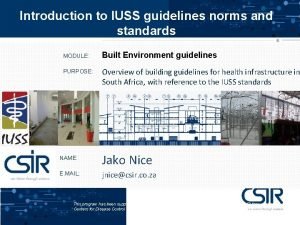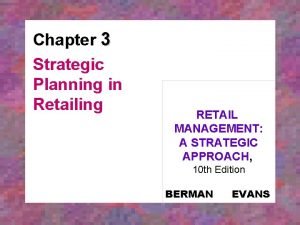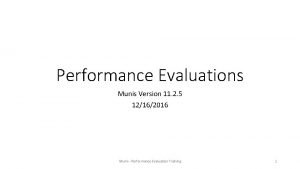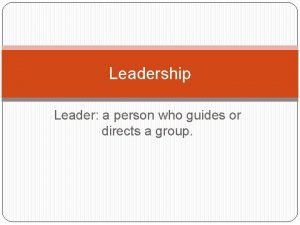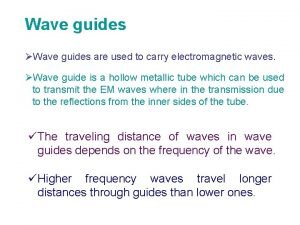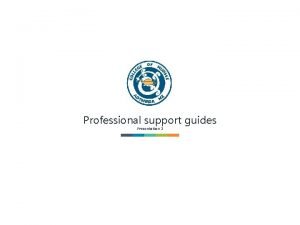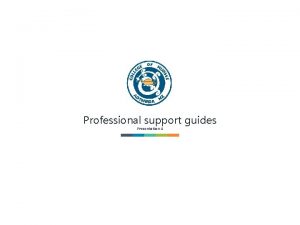CVISN Guides Management Guides Introductory Guide to CVISN



















- Slides: 19

CVISN Guides Management Guides Introductory Guide to CVISN Guide to Program and Project Planning CVISN Guide to Phase Planning & Tracking Technical Process Guides CVISN Guide to Top-Level Design CVISN Guide to Integration & Test Technical Application Guides CVISN Guide to Safety Information Exchange CVISN Guide to Credentials Administration CVISN Guide to Electronic Screening

Improved credentials administration should make government and business more efficient. Carriers Renewal Notice and Data Application State CV Administration Systems Credential • Process applications and tax returns • Evaluate • Issue credentials • Accept electronic payments • Apply for credentials Invoice • File tax returns Payment/Notice • Make of Payment payments (via EFT or other) Other States Details Summary of fees due/ owed Clearinghouses • IFTA and IRP CH support base state agreements • IRP CH also supports electronic funds exchange between states State-to-clearinghouse details from approved applications/tax returns; Clearinghouse-to-state report on info processed, including summary of fees due from/owed to state); IRP CH also supports state-tostate payments

Vision: Electronic Business Transactions Standard Electronic Data Interchange (EDI) Transactions Credentials, Taxes, Safety Records, HAZMAT, Insurance, Shipments, Payments Carrier Base State WIRELINE Wide Area Communications Canada Interstate Transactions Mexico Shipper, Bank, Insurer, Lessor, Service Bureau

Functional Thread Diagram: IRP Supplement, Add Vehicle CVIEW updates SAFER (MD Design using VISTA/RS Product and Inter. CAT) Generic State Commercial Vehicle Administration Systems VISTA/RS IRP Office 13 14 1 6 Service Providers Carrier Systems Credentialing System (e. g. , CAT) 7 8 15 Internet Tools 5 Credentialing Interface (CI) L M L S I IRP 4 L S I L M SSRS L S I L M Driver Licensing L S I L M ASAP MCDC Titling 2, 3 L S I L M Intrastate Veh Registration IFTA Tax Processing C CVISN Core Infrastructure Systems (National/Regional) E-Screening Enrollment B CDLIS L S I L M IFTA Registration L S I L M Haz. Mat L S I L M CAPRI L S I L M OS/OW L S I L M Treasury or Revenue L S I L M SAFETYNET L S I L M State Database Web CAT Other Carrier Systems L M D IRP Clearinghouse A IFTA Clearinghouse NMVTIS 9, 16 RSPA Haz. Mat CV Info Exchange Window (CVIEW) 10, 17 MCMIS 11, 18 SAFER Generic State Roadside Systems Carrier Commercial Vehicle Screening L M Licensing & Insurance Roadside Operations 12, 19 ASAP Analysis Admin/CAPRI Transponder Sensor/ Driver Comm L S I L M Citation & Accident L M ASPEN Other Jurisdictions B C D

CVISN Guidelines for Interface Design

A state Web site approach provides a person-to-computer interface. State Carrier World Wide Web Browser Credentialing Systems with Web Site HTML or XML, HTTP Web standards; no credentialing standards used States can provide electronic credentialing using a Web site. The carrier would access the Web site using a commercial browser (e. g. , Netscape) and manually enter the required data.

Example Web-Enabled CI System Design Carrier State Systems Firewall 1 Browser Credentialing Web Site DMZ Firewall 2 MVA DB Data Base (stored procedures) IRP backend Stand-Alone CAT Web Files Core Credentialing Interface CI UI Client IRP Office CAT Legend: solid blue arrows indicate access through firewall State CVIEW

The standard CVISN Level 1 credentials administration interfaces illustrated using the generic state system design CR in process: X 12 TS 286, 997 Generic State Commercial Vehicle Administration Systems X 12 TS 151, 813, 997 Credentialing Interface (CI) Service Providers Carrier Systems Credentialing System (e. g. , CAT) Internet Tools X 12 TS 151, 286, 813, 997 L S I L M Other Carrier Systems SSRS L S I L M Driver Licensing L S I L M Titling ASAP MCDC X 12 TS 286, 997 L S I L M IRP L S I L M IFTA Registration L S I L M X 12 TS 286, 997 Haz. Mat OS/OW L S I L M IFTA Tax Processing E-Screening Enrollment X 12 TS 285, 824, 997 X 12 TS 826, 997 X 12 TS 286, 997 L M Intrastate Veh X 12 TS Registration 285, 824, 997 CDLIS CR in process: L S I L M CAPRI IRP Clearinghouse L S I L M Treasury or Revenue IFTA Clearinghouse Web CAT L S I CVISN Core Infrastructure Systems (National/Regional) NMVTIS SAFETYNET CV Info Exchange Window (CVIEW) RSPA Haz. Mat X 12 TS 285, 824, 997 MCMIS SAFER KEY Open standards directly associated with electronic credentialing Interfaces associated with other aspects of Credentials Administration (maintaining snapshots, supporting base state agreements via clearinghouses) Internet standards used to support electronic credentialing Licensing & Insurance ASAP Analysis Admin/CAPRI X 12 TS 285, 824, 997

EDI Interface Specifications Baseline Specifications COACH Part 4, Interface Specification Checklists (“The Big Picture”) ANSI ASC X 12 Standards Application-Specific Implementation Guides & Code Directories, e. g. , TS 286 Vol. I - IRP Vol. III - IFTA (Credentials & Interstate) (Vol. V - Intrastate Registration) Jurisdiction-specific business rules (Vol. II - IRP Interstate) Vol. IV - OS/OW FHWA Code Directory Jurisdiction’s existing database designs Review Baseline Specifications & jurisdiction-specific information To be published by each State beginning in 1999 Jurisdiction-specific Motor Carrier E-Credentialing EDI Interface Control Document (ICD) (www. state. <mystate>. us/…/MC EC EDI ICD)

Telecommunications & Network Specifications Baseline Specifications Protocol Standards (e. g. , SNA, TCP/IP) Network Technology Specifications (e. g. , ISDN, frame relay) Networking Services (e. g. , Internet provider, AAMVAnet) Jurisdiction-specific policies & procedures Jurisdiction-specific network design Motor Vehicle Administration Public Utility Commission (Transportation Division) ASPEN Carrier SAFETYNET Intrastate. Licensing IRP Web CAT Credentialin CVIEW g Interface, Registration & 2000 Registration & Titling All MVA Dedicated dial-up Permitting LSIs, Dial-up CVISN Core E-Screening Infrastructure Systems Enrollment AAMVAnet SAFER/ Firewall Frame Relay Data Mailbox Carrier Systems (TCP/IP) Licensing & Firewalls dial-up Insurance CAT Internet CDLIS GW Repeater (token AAMVAnet MCMIS ring) SNA sensors RSPA Haz. Mat IRP Clearinghouse Sensor/ Screening Roadside CAPRI Treasury: IFTA Registration IFTA State Comm Police (Commercial. Operations Vehicle Enforcement) Mainframe Motor Fuel. DB Tax Division Driver & IFTA Tax Clearinghouse Processing Review Baseline Specifications & jurisdiction-specific information To be published by each State beginning in 1999 Jurisdiction-specific Motor Carrier E-Credentialing EDI Interface Control Document (ICD) (www. state. <mystate>. us/…/MC EC EDI ICD)

A stand-alone CAT (PC CAT) provides a computer-to-computer interface. Carrier State Or Service Bureau Stand-alone CAT Internet, Dial-up, or VAN EDI credentialing standards exist. Credentialing Systems Stand-alone CAT Optional use for state branch offices A carrier would enter vehicle information using the stand-alone CAT, where it would be stored locally. The stand-alone CAT would exchange credentialing information with the state using standards.

A CAT module could be integrated into existing fleet management systems to provide a computer-to-computer interface Carrier Fleet Management System (including CAT Module) State Internet, Dial-up, or VAN Credentialing Systems EDI credentialing standards exist. CAT credentialing capabilities are integrated in carrier Fleet Management Systems (FMS) that already contain carrier and vehicle related information needed for credentialing and use EDI for financial information. The CAT module in the FMS would exchange credentialing information with the state using standards.

A CAT module could be integrated into existing fleet management systems to provide a computer-to-computer interface Carrier Fleet Management System (including CAT Module) State Internet, Dial-up, or VAN Credentialing Systems XML credentialing guidelines could be developed. CAT credentialing capabilities are integrated in carrier Fleet Management Systems (FMS) that already contain carrier and vehicle related information needed for credentialing. The CAT module in the FMS would exchange credentialing information with the state using XML toolset.

Dual Interface: A state could implement both a Web site and a computer-to-computer interface. State Carrier 1 Web Browser Carrier 2 PC CAT or CAT Module World Wide Web Credentialing Systems with Web Site HTML or XML, HTTP E-mail or FTP EDI / XML / other file format This approach gives carriers a choice of options. It provides the benefits of both interface types, at additional cost to the state.

Keep the same “back end” processes, regardless of the external interfaces for credentialing State Systems Stand-Alone CAT Terminal Client Fleet Management System Browser Terminal Server C A T Web & XMLEnabled Credentialing Interface EDI I/F XML I/F Credentialing Web Site Web Database Core CI Database IRP IFTA Reg IFTA Tax Filing CVIEW

States are encouraged to implement CVISN Level 1 capabilities incrementally in a series of steps using a structured process 1 B Write State CVISN Program Plan 1 C Establish Funding & Contracts 2 to N 1 A Develop State Top-Level Design Develop Products & Integrate into Phase “n” CVISN Configuration

A planning process is necessary to plan the work and communicate among team members. Define the Objectives Create the Work Breakdown Structure Define the Processes ts jec k& ac 4 ro db d. P an Define the Organization m e Fe 3 ra og Pr 2 n Pla 1 Ite on i rat 5 Assign the Work to Organizations 6 Define Milestones & Schedules 7 Estimate Costs & Resources

The final phase of program organization is to obtain funding and contract for necessary products and services. Determine Potential Funding Sources 1 on ati Award Contracts t ter &I 7 ac ck ba Evaluate Proposals 6 ntr ed Issue RFP 5 Co Fe Prepare Technical Specifications 4 & Obtain Funding Commitments 3 nd Fu Prepare Funding Request Documents 2

Each state develops detailed designs and implements systems adapted to its unique requirements 1 Update Plan for Next 3 -6 Months 3 Document Interface Designs on ati ter &I 5 Integrate Product Releases 6 System Test 7 Acceptance Test (incl Interoperability) s ck ba Develop Next Product Releases tem ed Fe 4 ys t. S en lem Analyze Detailed Requirements p Im 2
 Anticipation guides examples
Anticipation guides examples Othello summary act 2
Othello summary act 2 Libguides unisa
Libguides unisa Iuss standards
Iuss standards Strategic retail planning
Strategic retail planning How to change artboard units in illustrator
How to change artboard units in illustrator Valve guide knurling tool
Valve guide knurling tool Association of ukrainian guides
Association of ukrainian guides Builders and property developers module in tally.erp 9
Builders and property developers module in tally.erp 9 Orange section of emergency response guidebook
Orange section of emergency response guidebook Kde munis guides
Kde munis guides Bharat scouts and guides
Bharat scouts and guides Whose voice guides your choice
Whose voice guides your choice Wwc practice guides
Wwc practice guides God guides me
God guides me Person who guides or directs
Person who guides or directs Introductory paragraph format
Introductory paragraph format Must not sentences examples
Must not sentences examples Variables and expressions 1-1 answer key
Variables and expressions 1-1 answer key Introductory paragraph for persuasive essay
Introductory paragraph for persuasive essay



